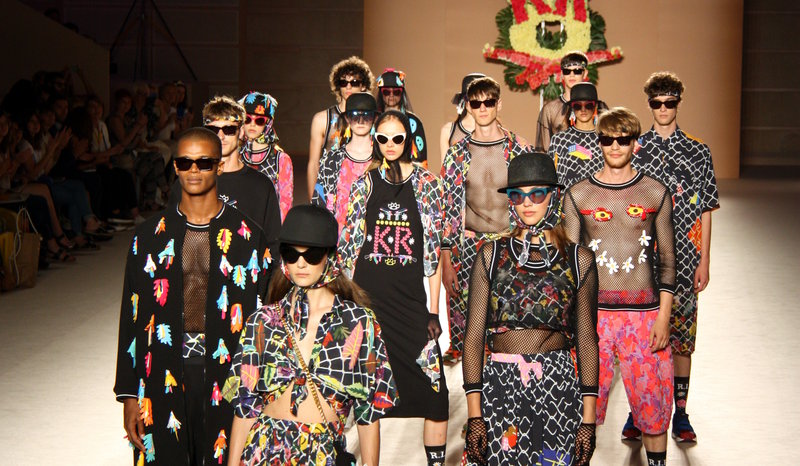Ready, set, design
Fashion in Catalonia and Spain gave the world the concept of the fashion franchise par excellence. Our latest gift to the world's catwalks is fast fashion and fast design
The French have this marvellous saying: plus ça change, plus c'est la même chose. The more things change, the more they stay the same. It was written in fact by the essayist Jean-Baptiste Alphonse Karr way back in 1849 and if it has been around and in use since then, there must be a grain of truth to it. Personally, I would find it hard to come up with a better way of expressing what fashion is. It borders on a paradox because the contradiction contradicts itself. The static is changeable and the changeable is static. What a mess! It is like the Iain Banks conundrum: what happens if an unstoppable force meets an immoveable object? (Answer at the end of the article, so read on).
Fashion feeds off change and creates a level of energy that most people outside the world of the creatives would find hard to keep up with. It really is a question of “here today, gone tomorrow.” Just when you think you have things worked out, everything just, well, dissappears.
In our September 2015 issue we interviewed Miriam Victoria, president of the Associació Moda de Catalunya i Balears. When asked about the changes in marketing and sales, especially in the light of the advent of online sales and designers skipping the middle men, she explained that in her view this was not necessarily a trend, rather a model that for the time being worked, but one that could change at any time. Design adapts, she said, and designers have no problems with that. The problem is whether the business infrastructure can keep up. This, later in the interview, also touched on the problem of financing designers. An investor in the design world is entering into unknown territory mostly, and as any backer does, wants a say in how things are run. That does not work in fashion.
The functioning fashion model is centred on the designer, not the business structure. The structure is moulded according to the needs of the particular designers. Desigual even breaks this down to “design clusters”, each working independently and each with its own support. To put if bluntly, the designer is God.
This explains the enormous success of the Spanish fashion franchise phenomenom. In fact, Spain's expertise in franchising in general terms is dazzling. But I digress. In world terms, the only fashion franchise operation that comes anywhere near the likes of Mango, Zara, and to a lesser extent Pronovias, is the Swedish company, H&M. In our November 2014 issue we talked of Mango claiming it would open one outlet a day during the whole of 2010. It did. 365 shops. But then in 2011, it opened 500 more. Nobody, nowhere, does it better. The Mango model, this enormous world wide emporium, has never lost sight of the fact that it is centred on the designers. And that means very special designers. Step in the latest gift we are giving the world: fast fashion, and the designers that go with it.
In general terms, education in Catalonia and Spain is, to say the least, conservative, even in the creative spheres. Not so, happily, for fashion. Our fashion design schools are relatively small and spread equally between Barcelona and Madrid, and they are marvellous.
The change has come about with the educators as much as with their “uncut diamonds” because that is how they see their students. Theses designers in the raw are the focus of the process and while their teachers, creatives one and all, are preparing them for their futures, are aware their own view of what the future may be, could possibly turn out to be something entirely different.
The profile of the students has changed as well. Many of them enter design with clear professional objectives mapped out and quite often that means setting aside some of the individualism of a natural creative in order to enter the world of “fast fashion” which demands team work and a certain level of business savvy.
Enter Inditex and the great fashion Talent & Co. Since 2014 the giant has worked with 24 design schools on the basis of what is really a competition, culling the schools for the top talent, accepting the winners into their own system. It has worked and the offshoot is that it is generating a change in how we educate our designers. Catalonia's sadly missed ModaFad was a similar innovation and many of the names we have seen this last week on 080 Barcelona were products of a powerful motivational and educational gambit which worked.
Given Spain's appalling level of unemployment among younger job seekers, fashion design is one area where statistics are encouraging. LCI Barcelona, like many other schools, takes in small numbers each year. Of the 31 graduates from last year's crop, 27 are now working, and most in their field of choice.
Would educators (being one myself) please take note?
Within the world of design there are other interesting aspects of education worth studying and perhaps next year Catalan Chic will do just that.
Many of those schools were on show last week in 080 Barcelona. Perhaps the most well know is L'Escola Superior de Disseny de Moda, LCI Barcelona, founded by Felicidad Duce in 1928. It is a story of evolution and dedication to the world of fashion but from the ground up, starting with the designers. Taking a different, more holistic vantage point is IDEP Barcelona, Escola Superior d'Imatge i Disseny. If I could start my photographic life again, perhaps it would be there.
Oh yes, the answer to the Banks conundrum. Well, the immoveable object moves and the unstoppable force, stops.

